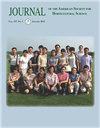利马豆生长、叶片气孔和光合作用的非症状限制,以及对盐水灌溉的13C判别
IF 1.1
4区 农林科学
Q3 HORTICULTURE
Journal of the American Society for Horticultural Science
Pub Date : 2021-03-01
DOI:10.21273/JASHS04996-20
引用次数: 2
摘要
土壤盐碱化是一个普遍存在的严重影响作物生产的问题。了解盐胁迫如何影响生长控制光合性能对于提高作物耐盐性和减轻盐的影响至关重要。利马豆(Phaseolus lunatus)是一种重要的作物,但关于其生长和与广泛盐度有关的叶片气体交换的信息很少。在本研究中,评估了在灌溉水中电导率(EC)分别为2.9(对照)、5.7、7.8、10.0、13.0和15.5 dS·m−1的六种盐度下,lima bean(cv.Fordhook 242)的叶气交换和全株生长的响应。随着盐度的增加,植物生物量、大豆产量和叶片净碳同化率(A)呈显著的线性下降。当EC从对照增加到15.5 dS·m−1时,植物生物量和A在营养生长阶段分别下降了87%和69%,在结荚生长阶段分别降低了96%和83%,大豆产量下降了98%。从线性关系来看,A的减少在生长减少和大豆产量损失中占很大比例。盐度对叶片气孔导度(gS)也有显著的负向和线性影响。叶片细胞间CO2浓度(Ci)和叶片C13同位素鉴别(Δ13)随盐度的增加而显著下降。A-Ci曲线分析显示,随着EC从对照增加到最高水平,气孔对A的限制[Lg(百分比)]显著线性增加,在营养期和荚灌浆期分别从18%增加到78%和从22%增加到87%。因此,对A的相对非芳香或生物化学限制[Lm(百分比),Lm=100−Lg]对盐度的增加产生了负面反应。这一结果与观测到的Δ13盐响应趋势一致。此外,叶片羧化效率和CO2饱和光合能力[最大A(Amax)]不受盐度增加的影响。我们的研究结果有力地表明,盐胁迫导致利马豆A的减少主要是由于气孔限制,光合作用的生化特性可能不会受到损害。由于气孔限制正是由于降低了叶片的CO2可利用性而降低了A,因此在CO2浓度升高的情况下增加CO2供应可能会提高盐胁迫的利马豆叶片的A,并减轻盐的影响。这得到了我们的发现的支持,即50%Amax的外部CO2浓度在两个生长阶段都随着盐度的增加而显著线性增加。随着盐度的增加,叶片水分利用效率呈上升趋势,叶片叶绿素-土壤植物分析发展(SPAD)读数没有明显下降。本文章由计算机程序翻译,如有差异,请以英文原文为准。
Lima Bean Growth, Leaf Stomatal and Nonstomatal Limitations to Photosynthesis, and 13C Discrimination in Response to Saline Irrigation
Soil salinization is a widespread problem severely impacting crop production. Understanding how salt stress affects growth-controlling photosynthetic performance is essential for improving crop salt tolerance and alleviating the salt impact. Lima bean (Phaseolus lunatus) is an important crop, but little information is available on its growth and leaf gas exchange in relation to a wide range of salinity. In this study, the responses of leaf gas exchange and whole plant growth of lima bean (cv. Fordhook 242) to six salinities with electrical conductivity (EC) of 2.9 (control), 5.7, 7.8, 10.0, 13.0, and 15.5 dS·m−1 in irrigation waters were assessed. Significant linear reduction by increasing salinity was observed on plant biomass, bean yield, and leaf net carbon assimilation rate (A). As EC increased from the control to 15.5 dS·m−1, plant biomass and A decreased by 87% and 69%, respectively, at the vegetative growth stage, and by 96% and 83%, respectively, at the pod growth stage, and bean yield decreased by 98%. Judged by the linear relations, the reduction in A accounted for a large portion of the growth reduction and bean yield loss. Salinity also had a significantly negative and linear effect on leaf stomatal conductance (gS). Leaf intercellular CO2 concentration (Ci) and leaf C13 isotope discrimination (Δ13) declined in parallel significantly with increasing salinity. The A-Ci curve analysis revealed that stomatal limitation [Lg (percent)] to A increased significantly and linearly, from 18% to 78% and from 22% to 87% at the vegetative and pod-filling stages, respectively, as EC increased from the control to the highest level. Thus, relatively nonstomatal or biochemical limitation [Lm (percent), Lm = 100 − Lg] to A responded negatively to increasing salinity. This result is coincident with the observed Δ13 salt-response trend. Furthermore, leaf carboxylation efficiency and CO2-saturated photosynthetic capacity [maximum A (Amax)] were unaffected by increasing salinity. Our results strongly indicate that the reduction in lima bean A by salt stress was mainly due to stomatal limitation and biochemical properties for photosynthesis might not be impaired. Because stomatal limitation reduces A exactly from lowering CO2 availability to leaves, increasing CO2 supply with an elevated CO2 concentration may raise A of the salt-stressed lima bean leaves and alleviate the salt impact. This is supported by our finding that the external CO2 concentration for 50% of Amax increased significantly and linearly with increasing salinity at the both growth stages. Leaf water use efficiency showed an increasing trend and no evident decline in leaf chlorophyll soil plant analysis development (SPAD) readings was observed as salinity increased.
求助全文
通过发布文献求助,成功后即可免费获取论文全文。
去求助
来源期刊
CiteScore
3.80
自引率
0.00%
发文量
31
审稿时长
2 months
期刊介绍:
The Journal of the American Society for Horticultural Science publishes papers on the results of original research on horticultural plants and their products or directly related research areas. Its prime function is to communicate mission-oriented, fundamental research to other researchers.
The journal includes detailed reports of original research results on various aspects of horticultural science and directly related subjects such as:
- Biotechnology
- Developmental Physiology
- Environmental Stress Physiology
- Genetics and Breeding
- Photosynthesis, Sources-Sink Physiology
- Postharvest Biology
- Seed Physiology
- Postharvest Biology
- Seed Physiology
- Soil-Plant-Water Relationships
- Statistics

 求助内容:
求助内容: 应助结果提醒方式:
应助结果提醒方式:


